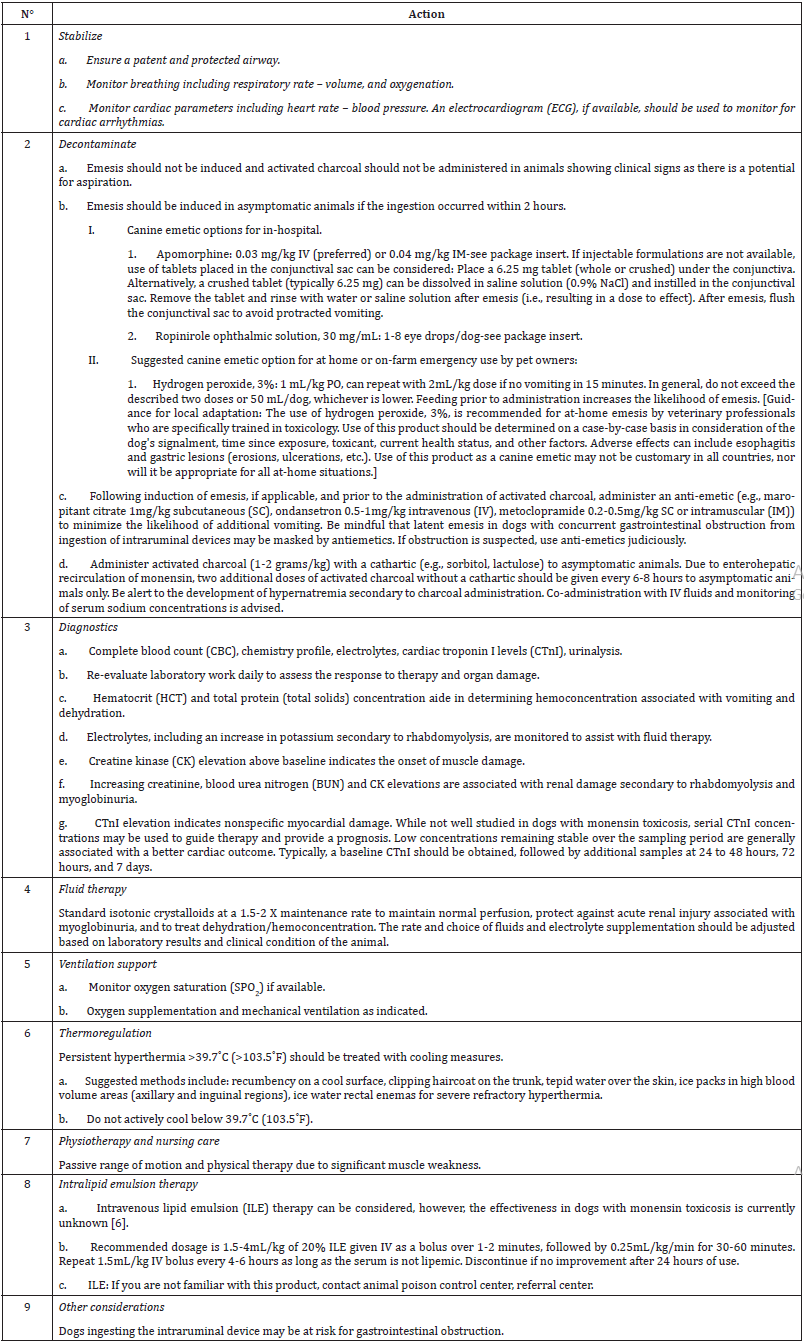Short Communication 
 Creative Commons, CC-BY
Creative Commons, CC-BY
Guidelines for Treatment of Monensin Toxicosis in Dogs
*Corresponding author: Frédéric Vangroenweghe, Elanco Animal Health Belgium, BU Ruminants & Swine, Generaal Lemanstraat Antwerpen, Belgium, Department of Internal Medicine-Reproduction-Population Medicine, Ghent University, Belgium.
Received: January 15, 2025; Published: January 21, 2025
DOI: 10.34297/AJBSR.2025.25.003337
Abstract
Monensin is a carboxylic ionophore with several labelled applications for use in poultry and ruminants. In Europe and Great Britain, the claims are for the reduction in the incidence of ketosis in the peri-parturient dairy cow and heifer, and as an aid in the prevention of coccidiosis in poultry. In ruminants, monensin is administered through an intraruminal slow release (95 days) device, that may be emitted in some cases. Farm dogs or dogs walked unattended on farmland may come into contact in case emission takes place before all monensin containing tablets inside the device are dissolved. Furthermore, unintended exposure can happen when dogs have access to devices before administration, due to poor storage strategy or due to devices in reach of dogs during the process of administration. This short communication aims to summarize the most important steps in the treatment of monensin intoxication in dogs through contact with the active ingredient present in the intraruminal device.
Keywords: Monensin, Intoxication, Dog, Treatment advice
Introduction
Monensin is a carboxylic ionophore with several labelled applications for use in poultry and ruminants. It is available globally for administration to various species with different indications depending on country or region. In Europe and Great Britain, the claims are for the reduction in the incidence of ketosis in the peri-parturient dairy cow and heifer, and as an aid in the prevention of coccidiosis in poultry. In ruminants, monensin was administered through an intraruminal slow release (95 days) device equipped with two wings to prevent return of the device upon rumination activity. However, in some cases, the intraruminal device is emitted before the monensin containing tablets are dissolved and dogs may come into contact with the remaining monensin present inside the device. Furthermore, unintended exposure can happen when dogs have access to devices before administraton, due to inappropriate Storage or due to devices in reach of dogs during the process of administration.
Monensin Intoxication in Dogs
The established acute oral LD50 in dogs is 10 mg/kg in females and 20 mg/kg in males [1]. Clinical signs of toxicosis develop rapidly, within 4-24 hours, and can persist for days to months, with some potentially lifelong. Affected organs are those found in the musculoskeletal, cardiovascular, gastrointestinal, respiratory, and neurologic systems. Signs most observed in dogs include anorexia, vomiting, muscle weakness, ataxia, progressive paresis/paralysis beginning in the posterior area and moving forward, recumbency, arrhythmias, seizures, and death [1,2]. Diarrhea is rarely observed in dogs [1]. Persistent/long-term signs include cardiac disease, paresis, and muscle weakness [4-6].
There is no antidote for monensin toxicosis. The exact mechanism of toxicity remains unknown, and therefore the treatment consists of aggressive and prompt supportive care until signs have resolved. Prognosis is poor if prompt treatment is not initiated. Prognosis is moderate to good with prompt treatment.
Treatment Advice for Monensin Intoxication in Dogs
Specific treatment advice following monensin toxicosis consists of specific steps, as given in Table 1.
These are guidelines only. Treatment should be based on a complete history, physical examination, and patient assessment by a veterinarian.
Discussion with Elanco Animal Health and / or use of this treatment guideline should in no way replace consultation with appropriate veterinary emergency or referral center personnel.
Acknowledgement
None.
Conflict of Interest
None.
References
- Novilla M (2018) Ionophores. In: Gupta R., Veterinary Toxicology. 3rd Elsevier: 1073-1091.
- Bosch L, Bersenas AM, Bateman S (2017) Acute polyneuropathy with respiratory failure secondary to monensin intoxication in a dog. J Vet Emerg Crit Care 28 (1): 62-68.
- C Caldeira,WS Neves, PM Cury, P Serrano, MA Baptista, et al. (2001) Rhabdomyolysis, acute renal failure, and death after monensin Ingestion. Am J Kidney Dis 38: 1108-1112.
- Condon FP, McKenzie RA (2002) Fatal monensin toxicity in a dog after chewing a bovine intra-ruminal slow-release device. Aust Vet Pract 32: 179-180.
- Langhorn R, Willesen JL (2016) Cardiac troponins in dogs and cats. J Vet Int Med 30: 36-50.
- (2021) Plumb DC. Plumb’s Veterinary Drugs.




 We use cookies to ensure you get the best experience on our website.
We use cookies to ensure you get the best experience on our website.